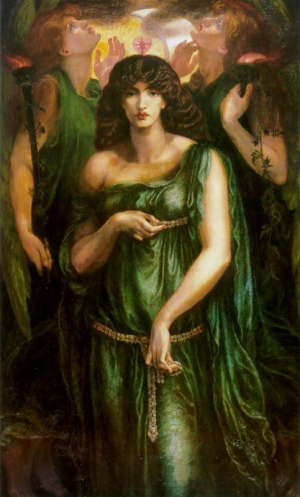
Sacred Texts Classics Lucian
Buy this Book at Amazon.com


Astarte Syriaca (1875-1877), by Dante Gabriel Rossetti (Public Domain Image) |
The Syrian GoddessDe Dea Syria, by Lucian of Samosataby Herbert A. Strong and John Garstang[1913] |
Lucian of Samosata's De Dea Syria, (the Syrian Goddess) is one of the most 'notorious' classical writings. Not only does it acknowledge that at one time a paramount Goddess was worshipped in regions of the Ancient Near East, it goes into details of the practices of her devotees which later generations considered reprehensible. Nonetheless De Dea played an important role in the development of modern Neopaganism; Robert Graves cited it as one of the few actual accounts of ancient Goddess-worship.
Lucian recounts his personal observations of the worship of the Goddess Atargatis (a form of Isthar or Astarte) at the temple of Hierapolis, in what is today Turkey. Lucian writes in the style of Herodotus, and, remarkably, in Herodotus' dialect of Greek, which at that time was over five hundred years old. Lucian describes huge phalliform idols, cross-dressing priests who castrated themselves, ritual prostitution of female worshippers, and occasional infant human sacrifice. Unlike most of the other writings of Lucian, he is not being explicitly satirical or ironic, nor is he writing fiction. Strong and Garstang claim that this was largely a historically valid description, supported by other ancient writers, texts, and archaeology. Among other passages of interest, there is a variant account of the Greek flood myth of Deucalion which is here blended with pre-biblical Ancient Near Eastern deluge accounts.
Victorian and early 20th century scholars found this text difficult to process. It is conspicuously absent from the expurgated Fowler and Fowler translation of Lucian's Works of 1905. While A.M. Harmon included De Dea in volume four of the Loeb Classics Library Lucian in 1925, he rendered it in middle English! Harmon's rationale was that Lucian wrote De Dea in an archaic dialect of Greek, so this was an attempt to convey the experience of a contemporary of Lucian reading this. But it is not helpful for the modern non-academic reader. Fortunately, Strong had translated De Dea into clear modern English in 1913, and so this is the edition which I used. However, the Strong translation has never been reprinted and used copies are almost impossible to come by. I had to obtain a copy of this book by interlibrary loan from a small college in Pennsylvania. Even still, Strong and Garstang wreathe the translation in a thick nimbus of apparatus, which gives the appearance of a scholarly distancing tactic. This tendency has continued into the 21st century: a recent academic edition ran to 600 pages--all for a text about the length of a short magazine article. (Lucian, On the Syrian Goddess, J.L. Lightfoot, Oxford University Press [2003])
Lucian's authorship of De Dea has been questioned. One issue is the archaic dialect. In addition, his other works are quite cynical about religion. And where is Lucian's relentless humor? The effect is like watching Robin Williams do a completely straight reading of the Gettysburg Address. Is he being absurdist by affecting not only a different dialect, but a pious attitude, as some have suggested? Or is he being serious, for once? There is one clue: in a personal note at the end, Lucian says that a lock of his youthful hair was dedicated to the Goddess at this temple. This may hold the key to why he wrote this piece.